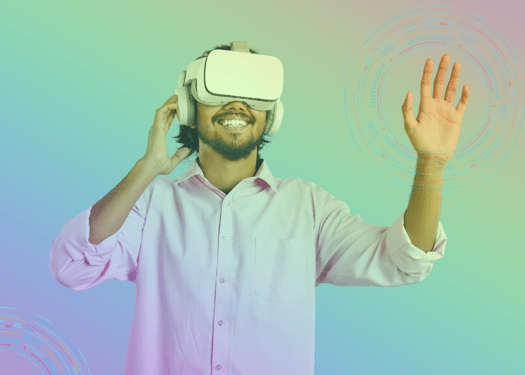While it may take its name from the Facebook rebrand name “Meta,” the Metaverse is anything but a singular entity. It encompasses virtually every aspect of Internet technology, particularly bandwidth-heavy AR and VR applications. Perhaps Wired.com had a good idea when they suggested replacing the phrase “the metaverse” in a sentence with “cyberspace.”
Of course, author Neal Stephenson never envisioned how his coined phrase and world of the Metaverse would take shape outside his book Snow Crash in 1992. Although, readers may find some striking similarities between his science fiction world and our current technological universe.
However you define it, everyone knows the Metaverse is coming and in many ways is already here. Big tech is already gearing up to accommodate AR- and VR-rich technology in the business and personal world. Let’s take a look at how the Metaverse will impact IT departments across the globe.
Significant VR Growth Metrics
The VR market continues to grow. The global virtual reality market size was valued at USD 21.83 billion in 2021 and is expected to expand at a compound annual growth rate (CAGR) of 15.0% from 2022 to 2030. That means an expected reach of 28.42 billion in 2022 and a projected level of 87 billion by 2030. And business is expected to become a primary driving force in VR growth, surpassing the gaming industry.
The highly stimulating environment of Virtual Reality that revolutionized gaming and entertainment has now found its way into numerous industries and military applications, including:
- Instruction
- Engineering design
- Medical care
- Architecture
- Event planning
- Real estate
The adaptation of this new technology into various business sectors is already propelling market growth. However, new penetrations into the consumer electronics industry are also a formidable driver of market growth.
- Head-mounted display devices (HMDs) are the most popular devices used with VR, generating over 60% of the total market share.
- Gesture-tracking devices (GTDs) are the fastest-growing segment in devices.
- Semi- and fully immersive technologies account for fully 80% of overall market share.
- New research is creating holographic windows that project people and objects into far-off spaces.
- New haptic (touch) gloves can enable users to interact with virtual objects and experience sensations like pressure, texture, temperature, and movement.
How will the business Metaverse look? One article in the Harvard Business Review states, “Within the metaverse, you can make friends, rear virtual pets, design virtual fashion items, buy virtual real estate, attend events, create and sell digital art — and earn money to boot.”
- Enjoy a virtual live conversation with colleagues in another location.
- Teleport to a distant country and meet with others in a virtual office setting.
- Send an AI-enabled twin of yourself to take notes at a meeting.
- Take a virtual test ride of a new vehicle from your living room.
- Experience life-like military training in the safety of a secure training location.
- Guide virtual consumers through a potential new home, with all parties located elsewhere.
- Create and sell virtual art.
- Nurture virtual pets.
As you can well imagine, all this requires a vast underpinning in infrastructure, including advanced computing power, versatile software, broad cloud storage options, support for new devices, and massive capacities for Internet connectivity.
How Will Businesses and IT Departments Need to Prepare?
Advanced technological challenges must be met with innovative and forward-thinking solutions. Will your business IT infrastructure stand up to the demands of AR and VR technology? For example, experts maintain that VR requires 20 times more storage space than HD video. And, VR requires up to six gigabytes of bandwidth per second. Current top-of-the-line solid-state drives only accommodate about 3.5 gigabytes per second.
What about the digital traffic in your business? Increased use of VR technology applications will substantially increase your traffic levels. Some estimates expect a 20-fold increase in digital traffic due to more AR and VR use.
Are your computers able to handle the load? Businesses and data centers alike will require new high-performance computing (HPC) capacity to handle and process increased data from AR and VR applications and devices. This is the only way to guarantee the seamless experience that is expected.
Even after upgrading your internal infrastructure to meet current and future demands for AR and VR technology in the Metaverse, you still need ensured uptime, network redundancy, and reliable dedicated Internet connectivity to keep you vitally connected with the rest of the world. Fixed Wireless Internet from MHO offers numerous benefits for handling your existing traffic as well as being well-prepared for what lies ahead.
- Enterprise-Class Service Level Agreements (SLA)
- No Data Caps
- Multi-protocol Label Switching (MPLS) Core Network
- Scalable Bandwidth
- Fast Installation
- Low Latency
Fixed wireless makes an excellent redundant solution backing up your existing fiber network, or as a primary that offers superior reliability, security, and overall satisfaction.
Contact us at MHO today to learn more.
{{cta(‘1b7ff105-cbb6-486e-888d-bb72f7746c39’)}}





![[Infographic] Fixed Wireless: What You Need To Know](https://blog.mho.com/wp-content/uploads/2017/06/Screenshot-2025-06-24-141710.png)
![[Infographic]: What Downtime Really Costs You](https://blog.mho.com/wp-content/uploads/2017/08/Screenshot-2025-06-24-141621.png)